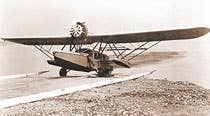
||| |---|---| | | | Greg Herrick, an avid vintage aircraft collector and founder of the Aviation Book Company, is pursuing the next great airplane for his collection-a 1930 Sikorsky S-39C flying boat. There's just one hitch: it's sitting on the bottom of a lake in Alaska.
When he began his quest for an S-39, Herrick found three of the airplanes, one in a museum, one in an unsalvageable heap and one that originally belonged to Victor Lenhart, who crashed it in Twin Lakes, Alaska, in 1958. But the National Park Service, which had been surveying the area at the time of the crash, rescued Lenhart and managed to scribble down the bearings of where the Sikorsky sank. In 1998, Lenhart and Herrick returned to the crash site.
Herrick bought the rights to the airplane for $25,000 and spent $150,000 last year trying to lift it from the lake bottom. During initial salvage attempts in the spring of 2000, the ropes pulling the airplane snapped against 14,000 pounds of pressure because the airplane was buried deep in silt. For two weeks straight, 15 people hauled excavating equipment into the remote area in Beavers and worked from inflatable boats trying to lift the aircraft from the bottom but were unsuccessful.
Alaska's warmest spring on record delayed the project again last March. Everything was set to go until 24 hours before starting the salvage operation, when Herrick had to stop the project because two inches of water pooled on top of the ice-covered lake. The surface proved too soft to plant stakes for securing the equipment framework needed to operate the silt extraction tubes underneath. Though Herrick knew a Shorts Skyvan could drop the team off at Two Lakes at the outset, he figured landing on the ice would be impossible at the end of the two-week project. Fortunately, the most expensive aspect of the project, importing a special portable decompression chamber and its salaried operator from Italy, was stopped.
Next spring, Herrick will try again. He already has assembled a team of 12, including contractors and scuba divers, to help clear the debris. A remotely controlled evacuation device will suck the silt off the airplane. The upside down parasol wing containing the engine has to be dislodged first. Once the airplane is freed, the team will tether cables and flotation devices to the Sikorsky to bring it up approximately 20 feet from the lake's surface.
"The determination to get the Sikor-sky to the surface has gone beyond the point of reason," says Herrick. If successful, the plan is to transfer the airplane by helicopter back to Minneapolis for restoration. Costs for Herrick on his second attempt have thus far amounted to over $250,000. Still, Herrick can't wait to retrieve, restore and fly the Sikorsky. "Heck, you only live once," he said.

Sign-up for newsletters & special offers!
Get the latest FLYING stories & special offers delivered directly to your inbox






